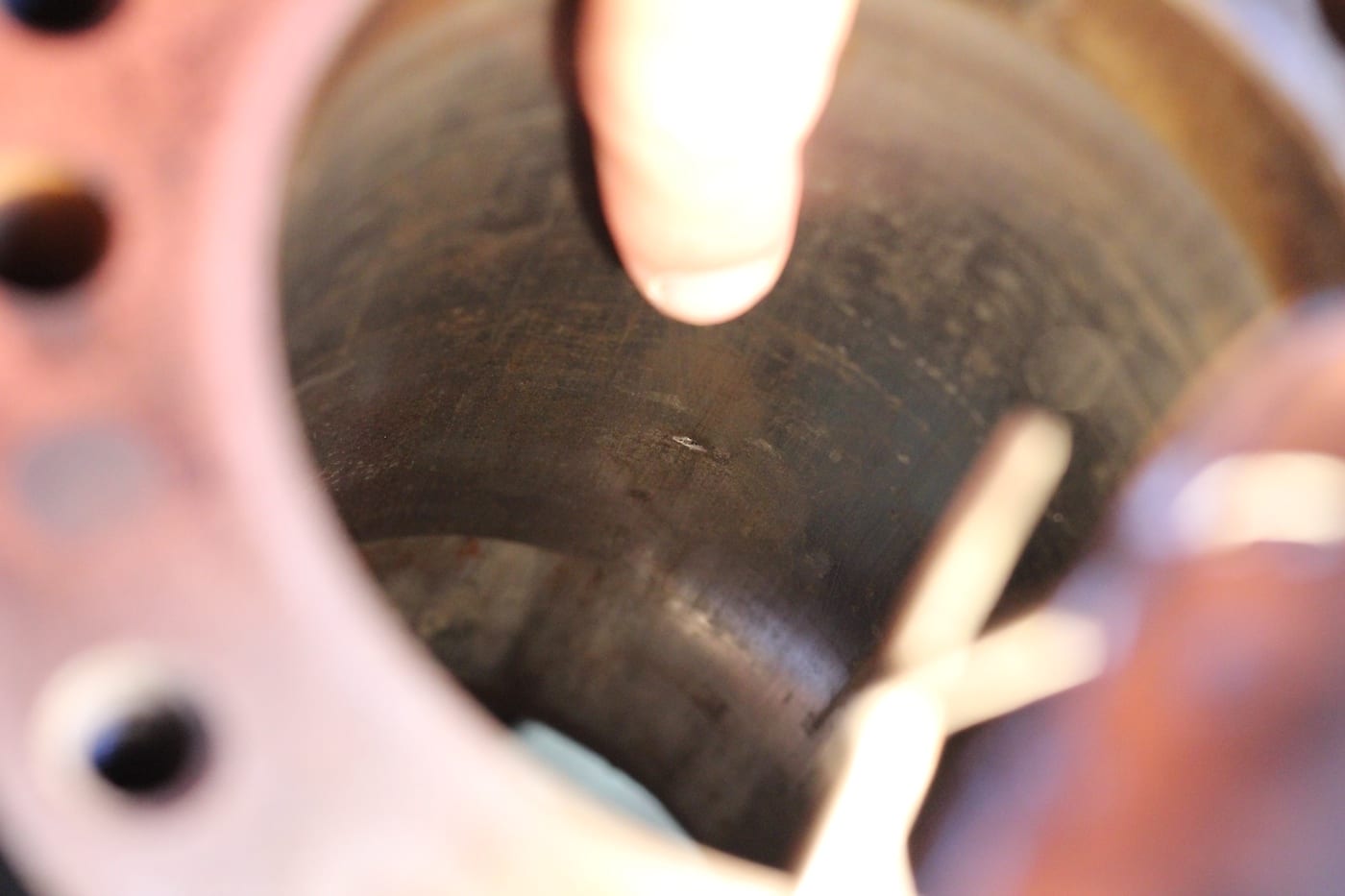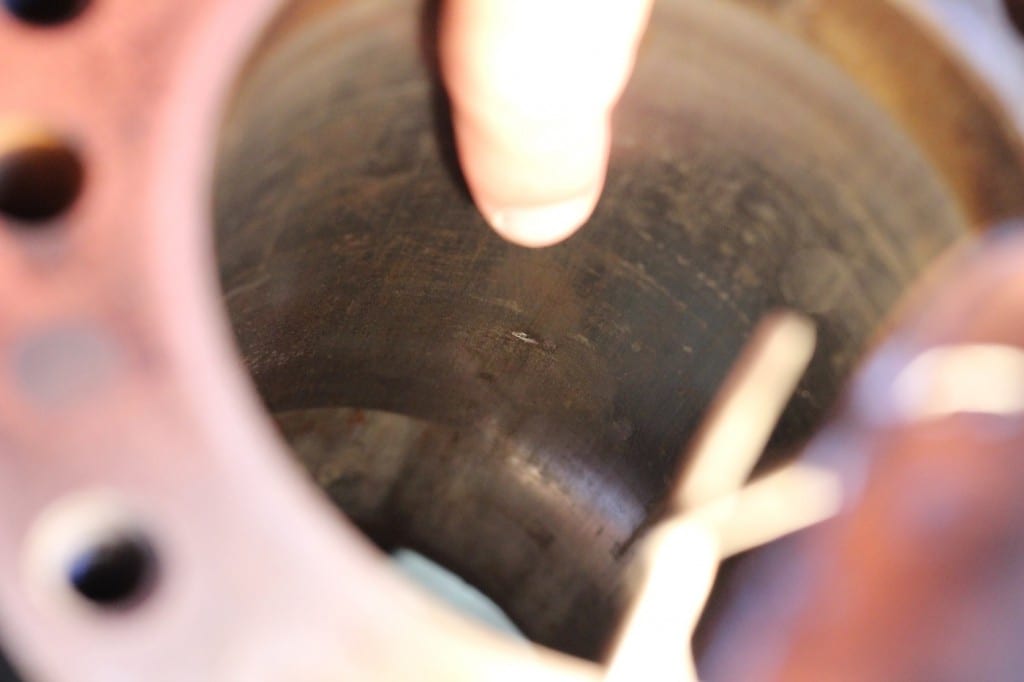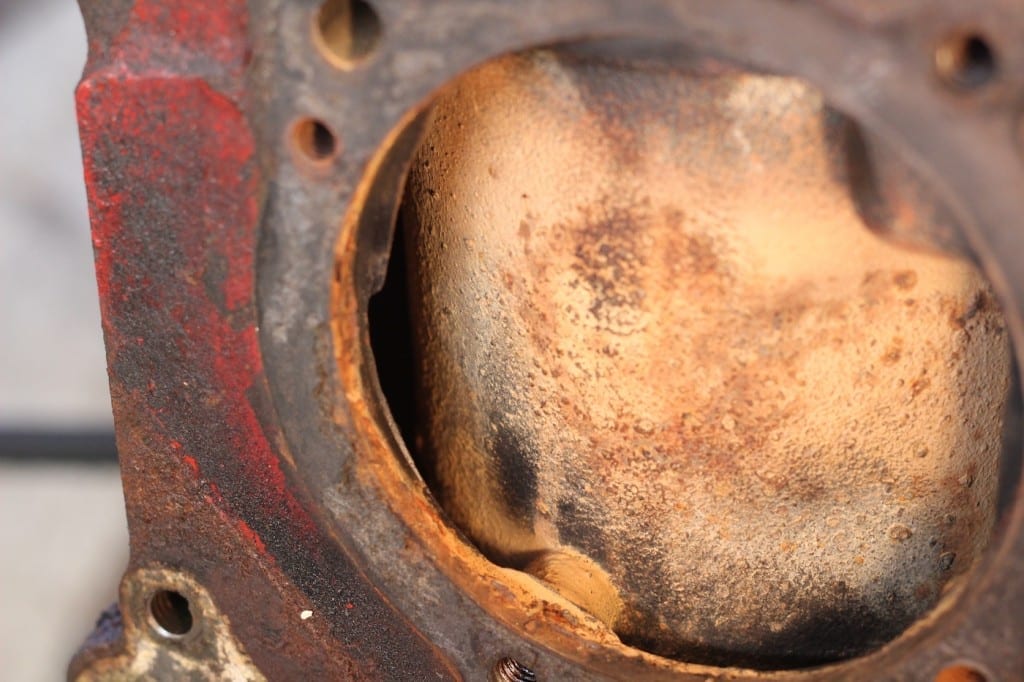So here is the hole that has caused all of this drama the past few months. This speck of a hole, about the circumference of a piece of pencil lead, was enough to sideline us all this time. In the other picture the hole is just out of sight around the left side of the number one cylinder.
Anyway, the block should be out tomorrow so that repair work can commence.
For anybody wondering, the shop I’m using charges 5,000 pesos to remove the engine and put it back in again when done. That’s about $400. Pretty fair I’d say for all the work involved.




33 Comments on “Hole in One”
halleluiah!! Get that hunk of metal fixed and get on with it:)
Heck if there removing it are you gonna go for a full rebuild on the motor?? Might as well.
I thought this engine had a heat exchanger, that is not raw water cooled. If that is the case why so much rust? In fact why any rust at all?
$400…gotta love Mexico man. I’d be happy to pay $1000 for that job and still feel I got a good deal
Regarding a rebuild, might be a good idea, at least things like the bearings, You’ve had so much coolant in the oil which reduces its lubrication this could have caused excessive wear on them. This happened to a Chevy S-10 Blazer I had when the head gasket failed and coolant got in the oil. Had excessive bearing noise and low oil pressure after getting the head gasket redone. Good luck, glad you solved the mystery.
Something I noticed in some of your pics of your trany to output shaft is the fact that you aren’t using a Polyflex Drive Coupling. The flex coupling is made from tough plastic and isolates your transmission and engine from vibration, galvanic corrosion through the output shaft and also acts to protect the trany from over torque failure when and if it gets wrapped on something.
Something you might want to look to install while the engine is out. They are typically 1 inch thick red plastic disks with bolt patterns to match your reduction gear output and your shaft collar.
Here is the link http://polyflex.com.au/4-Bolt50.php
If your boat was sitting for a long time prior to you buying it without zincs and no isolation between the engine and shaft, your engine would act as the galvanic anode since it is the least noble metal in the linkage and explain the engine corrosion issue you have.
Just something to consider.
Now is the time to bore and sleeve all the cylinders. Now that you have a good mechanic and good prices, do the whole shebang. You won’t regret it later. If you don’t, you might regret it later.
Ok, Im sailing to Mexico for my next round of mechanical work. $400?? wow. I would struggle to get a Australian Mechanic to get out of bed for that!
You got that right.
Now all you need is a turbocharger, some stickers, skis and some rope.
Keep doing what you are and thanks for sharing, this is interesting!
Hogan
As mentioned, bad engine zincs, or lack of them? Lots of rust in the cooling passages? Sleeving may just be a Band-Aid fix. If it corroded all the way through the jacket and cylinder it has likely corroded/anodized in other areas, more than just a little scaling?
No offense, however:
“Never time/money to do it right the first time but always time/money to do it over”?
Paul T
The corollary to “Never time/money to do it right the first time but always time/money to do it over” is
“A stingy man always pays twice.” Sorry Pat, I think you guys are truly awesome but that saying has been rattling around in my brain ever since this engine fiasco started.
Ok, so this engine has a “wet” cilinder liner design.
Change the cilinder liners are not that dificult but two good advises above:
1 – if you can, make an entire rebuild, if not, at least the crank bearings.
2 – The polyflex is a good solution for protecting the engine and transmission from impact and corrosion….
Rgds,
R
Sure glad it wasn’t a double bogey!
Seems odd that you weren’t seeing bubbles or over pressurization in the expansion tank. The hole also doesn’t explain the coolant under the head gasket, unless you had both a hole and a bad head gasket installation. I agree with the others that sleeving a corroding block seems like a temporary fix. But if you only plan to do coastal cruising in the foreseable future then I suppose you’re not risking much.
And much less than a good day of trading! Bargain!
So glad you found the source of your woes. It’s a Christmas miracle!
Mark and Cindy
If there’s corrosion in your engine block it’s not from galvanism. For an anode to be wasted it must be exposed to the same electrolyte as the cathode.
Absolutely not true…
You do realize that every steel bridge in the world has a anode blocks attached by cable…the anodes are not sitting in water. Electrons move across the conductive surface of metal. Electrolyte just makes that process faster.
In fact, rebar in concrete gets protected by zincs and there isn’t any electrolyte involved.
your persistence is admirable amigo
Even with fresh water cooled you can have crevice corrosion when coolant is old. The engine is a mess, toss it and get a nice Yanmar and never look back.
You know what I find amusing? The only people in a position to benefit from me tossing this perfectly good engine and replacing it are the mechanics. Yet they seem to be the only people not in a hurry to spend my money. In fact when they pulled the pistons and the rest of the guts out they asked me if I had already rebuilt the engine. That’s how good everything looked to them. They say it’ll go another twenty years no problem after this. They must be fools. It’s the only explanation. Eighty years of experience between the two of them, but clearly they don’t know what they are talking about. Oy.
I find your comment a little surprising. Every person that has commented to your blog whether value added or not, did so only because they care about you and your family. I’m sure after stumbling around for several months you’re eager to find a nice easy answer, but the reality is it’s not a “perfectly good engine”. In fact there is a hole in a cylinder wall which is pretty rare chit. How’d it get there? What makes you think there aren’t other areas of that block that aren’t just as thin?
One thing that is always interesting about the rescue stories of various sailboats abandoned at sea is there is always somewhere in the boats past where the owner knowingly cheaped out. It’s always a conscious decision to not replace something and that’s always what gets them. None of us has to rely on your boat so what you do doesn’t actually affect any of us. But the reality is your engine is scrap.
The inside of your cylinders exhibit substantial corrosion pitting which suggests systemic corrosion of the block. The fact that the pistons and rings are new also suggest that the last owner was forced to replace the them in order to make it run which means they were seized in place by corrosion. Any mechanic in the US will tell you that you have a bad block. However, you are in Mexico and getting a new engine or short block will be costly. I’m sure you can fix it as planned and it will run fine, but the likelihood of a failure of some kind is higher.
You are a statistics guy and considering the failures of the reduction output coupling and your engine mounts…
Agree with Jack. Again, I am not even close to being an expert but have been inside many engines over many years. First time I have seen or heard of a case exactly like yours. I would think there are other areas inside the block like the hole. Maybe things are nice & calm in Mexico but some day you might be trying to beat off a nasty lee shore with your wife & kids on board with an engine that can’t give you full power. Of course, you are there and we are somewhere else, offering what may be of some help to you, your call.
Paul T
I’ve done what I can and even bought a pizza 😉 Jack is right.
These prophesies of doom to Pat and his family if he doesn’t heed your advice to buy a new engine are bit over the top. You smug, holier-than-thou internet “experts” need to slow your roll.
Most people don’t live in a fantasy world where you drop tens of thousands of dollars on a new engine when the existing one can be repaired for a small fraction of the cost.
This “what if one day..” reasoning for buying a new engine is like buying a stupidly expensive insurance policy against an event that you have the ability to avoid. I’ve never seen anything on this blog to suggest that Pat would take his family out in waters worse than a mild seasickness inducing swell!
Dean…KMA;-)
My comments were not doom, but more of wanting the best for them, a new Yanmar is not that much money when you are long distant traveling, plus you get the resale when you move on vs that of an out of production Lehman. Heck a nice recon’ed Cummins 6B would fit nicely and serve very well. All about options.
The comments of Jack and Trim are right.
The block is thin and corroded. This motor with sleeves inserted will remain an unreliable ongoing source of problems on this boat regardless of how many years experience the mechanics down there have.